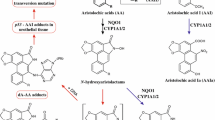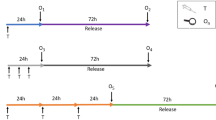Abstract
Despite good evidence for a genotoxic potential of ochratoxin A (OTA), the mechanism of OTA-induced genotoxicity (direct or indirect?) is still unclear. This calls for a further characterization of OTA-related DNA damage, and investigations of factors that may modulate dose-effect relationships in cells.
Since bladder epithelium is a target tissue for the toxicity of OTA, its effects were studied in cultures of human bladder carcinoma (H5637) cells. Cytotoxicity of OTA, assessed by Neutral red (NR) uptake or Alamar-Blue assay, is concentration- and time-dependent: Upon 24 h treatment of 5637 cells, NR uptake is reduced by 50% with OTA concentrations of ≥0.2 microM, but not with 3 h treatment of the cells. Since cytotoxicity of OTA was not affected by addition of xenobiotic metabolizing enzymes (S-9 mix), it appears to be unrelated to biotransformation of the mycotoxin. Also, addition of S-9 mix did not significantly affect the genotoxicity of OTA as studied by alkaline single cell gel electrophoresis (Comet assay). DNA damage was detectable after 3 h treatment of cells at OTA concentrations between 0.1 and 1 microM, and increased further at higher concentrations. The magnitude of OTA-induced DNA damage did not increase with longer treatment times (18, 24 h), probably due to repair processes in the cells. Repair of OTA-induced lesions is quite efficient in kidney (Arch Toxicol 2002, 75, 734–741) and in porcine bladder cells (Föllmann and Lebrun, 2005, Mycotoxin Research, this volume). Interestingly, the genotoxicity of OTA is modulated by the pH of the culture medium, with higher damage at pH 5 compared to pH 7.5. In line with this, uptake studies with tritiated OTA show a higher cellular accumulation of the mycotoxin at pH 5 than in buffer of pH 7.5. Thus, bladder cells exposed to OTA in slightly acidic urine (which facilitates reabsorption) may be at higher risk.
Similar content being viewed by others
References
Petzinger E, Ziegler K (2000) Ochratoxin A from a toxicological perspective. J Veter Pharmacol Ther 23: 91–98
Benford D, Boyle C, Dekant W, Fuchs R, Gaylor DW,et al. (2001) Ochratoxin A. In: Safety evaluations of certain mycotoxins in food, WHO Food Additives Series 47, FAO Food and Nutrition Paper 74, IPCS International Programme on Chemical Safety, WHO, Geneva, 281–387
Bolt HM, Foth H, Hengstler JG, Degen GH (2004) Carcinogenicity categorization of chemicals—new aspects to be considered in a European perspective. Toxicol Lett 151: 29–41
Degen GH (2002) Toxikologische Bewertung von Ochratoxin A: Offene Fragen und Forschungsbedarf. Mycotoxin Research Vol 18A: 117–122
Lebrun S (2003) Genotoxizität des Mykotoxins Ochratoxin A in vitro. Inaugural Dissertation, Universität Düsseldorf, Math.-Nat.-Fak. (Thesis)
Lebrun S, Föllmann W (2002) Detection of Ochratoxin A-induced DNA-damage in MDCK cells by alkaline single cell gel electrophoresis (Comet-Assay). Arch Toxicol 75: 734–741
Degen GH, Gerber MM, Obrecht-Pflumio S, Dirheimer G (1997) Induction of micronuclei with ochratoxin A in ovine seminal vesicle cell cultures. Arch Toxicol 71: 365–371
Föllmann W, Lebrun S (2003) Uptake and genotoxic effects of ochratoxin A in cultured porcine urinary bladder epithelial cells. Mycotoxin Research 19(1): 25–27
Föllmann W, Lebrun S (2005) Repair of ochratoxin A-induced DNA damage and modulation of OTA-related genotoxicity by coincubation with bile acids and methotrexate in vitro. Mycotoxin Research (this volume)
Jung KY, Takeda M, Kim DK, Tojo A, Narikawa S, Yoo BS, Hosoyamada M, Cha SH, Sekine T, Endou H (2001) Characterization of ochratoxin A transport by human organic anion transporters. Life Sci 69: 2123–2135
Berger V, Gabriel AF, Sergent T, Trouet A, Larondelle Y, Schneider YJ (2003) Interaction of ochratoxin A with human intestinal Caco-2 cells: possible implication of a multidrug resistance-associated protein (MRP2). Toxicol Letters 140–141: 465–476
Schaaf GJ, Nijmeijer SM, Maas RF, Roestenberg P, de Groene EM, Fink-Gremmels J (2002) The role of oxidative stress in the ochratoxin A-mediated toxicity in proximal tubular cells. Biochim Biophys Acta 1588: 149–158
Author information
Authors and Affiliations
Corresponding author
Additional information
Financial support Y. L. is supported by a stipend from the Deutsche Forschungsgemeinschaft to the International Graduate collegue “Molecular Mechanisms In Food Toxicology” at the University of Düsseldorf.
Rights and permissions
About this article
Cite this article
Degen, G.H., Lebrun, S., Lektarau, Y. et al. Modulation of ochratoxin A induced DNA-damage in urothelial cell cultures. Mycotox Res 21, 57–60 (2005). https://doi.org/10.1007/BF02954819
Issue Date:
DOI: https://doi.org/10.1007/BF02954819




